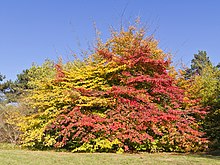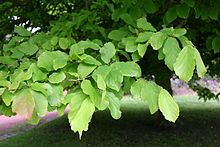Parrotia persica
| Parrotia persica | ||||||||||||
|---|---|---|---|---|---|---|---|---|---|---|---|---|

Inflorescence of the Persian ironwood tree ( Parrotia persica ) |
||||||||||||
| Systematics | ||||||||||||
|
||||||||||||
| Scientific name of the genus | ||||||||||||
| Parrotia | ||||||||||||
| CAMey. | ||||||||||||
| Scientific name of the species | ||||||||||||
| Parrotia persica | ||||||||||||
| ( DC. ) CAMey. |
Parrotia even Parrotie , Persian ironwood tree , Persian Ironwood , Ironwood and like many other plant species also ironwood called, is the only species of the genus Parrotia and belongs to the family of hamamelidaceae (Hamamelidaceae). The generic name Parrotia honors the German doctor and botanist Friedrich W. Parrot (1792–1841).
description
Appearance and leaf
Parrotia persica is a deciduous shrub or small tree that can reach heights of up to 10 meters. Single-stemmed specimens are usually noticeably low and already more branched close to the ground. Its trunks have a flaking scaly bark . The bark of young branches is covered with star hairs ( trichomes ). The winter buds are stalked and equipped with bud scales .
The alternate leaves are arranged in a petiole and a leaf blade. The petiole is 2 to 6 millimeters long. The simple leaf blade is obovate to elliptical with a length of 6 to 10 centimeters with a rounded to slightly heart-shaped base and a rounded upper end. The leaf margin is serrated in the upper half. Both spider surfaces are hairy. The autumn colors of the leaves are bright yellow, orange or orange-red. The large stipules are obsolete.
Inflorescence, flower, fruit and seeds
The flowering period extends from January to March and the flowers unfold before the leaves. Usually eight to ten flowers are in terminal, dense, head-shaped inflorescences . The heads are surrounded by one to 1.5 centimeters long bracts (bud scales) with deep brown hair on the outside . Parrotia persica is Andromonözisch , which means that one specimen has hermaphroditic and purely male flowers. The five to seven inconspicuous sepals are one to 1.5 millimeters long, green and tomentose at the tip. Petals are missing. The 14 stamens have hanging stamens up to 1.5 centimeters long with red anthers .
The two-seeded capsule fruit opens with two to four flaps. The elongated-elliptical seeds have a light brown sheen.
Chromosome number
The number of chromosomes is 2n = 24.
Systematics
The first description of Parrotia persica was made in 1830 by de Candolle Augustin-Pyrame as Hamamelis persica . In 1831, Carl Anton von Meyer combined the species into the genus Parrotia that he had newly established.
Dissemination and use
The parrotia is native to northern Iran and the Caucasus . This decorative plant species is occasionally found as an ornamental wood in parks and almost all botanical gardens.
swell
Individual evidence
- ↑ Parrotia persica at Tropicos.org. In: IPCN Chromosome Reports . Missouri Botanical Garden, St. Louis
- ↑ Prodromus systematis naturalis regni vegetabilis, Volume 4, p. 268, 1830 online
- ↑ Directory of the plants that were found and collected during the voyage undertaken in the years 1829 and 1830 in the Caucasus and in the provinces on the western shore of the Caspian Sea. P. 46, 1831, St. Petersbourg


